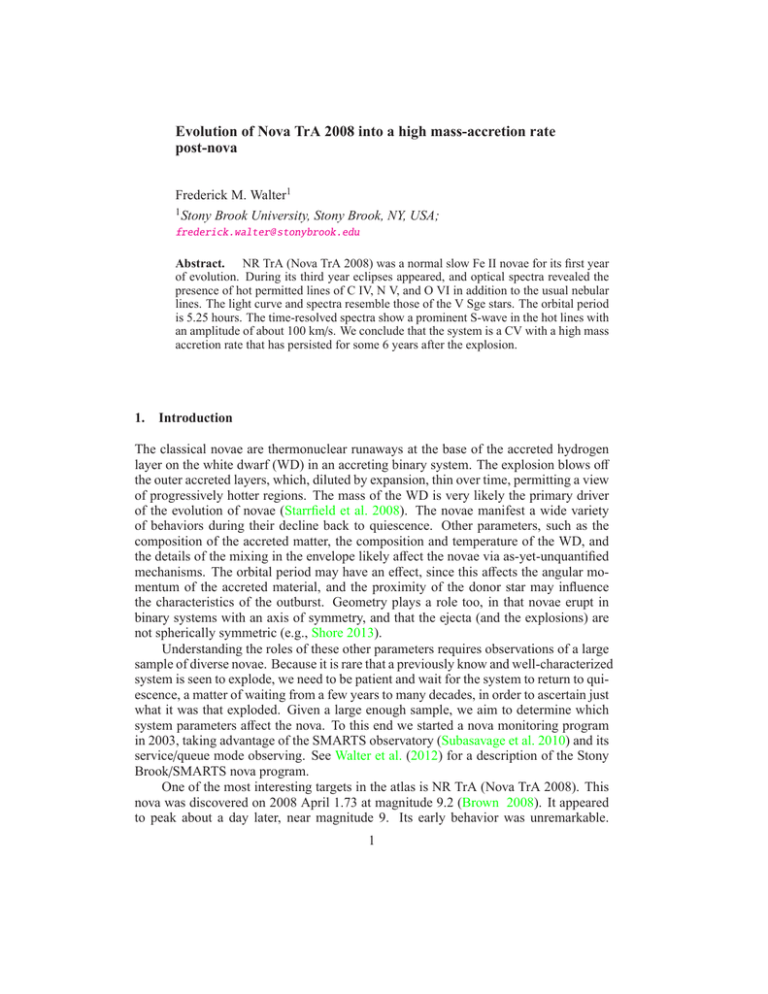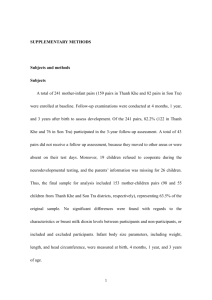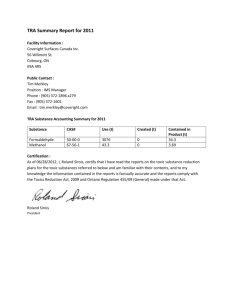Evolution of Nova TrA 2008 into a high mass-accretion rate post-nova
advertisement

Evolution of Nova TrA 2008 into a high mass-accretion rate post-nova Frederick M. Walter1 1 Stony Brook University, Stony Brook, NY, USA; frederick.walter@ stonybrook.edu Abstract. NR TrA (Nova TrA 2008) was a normal slow Fe II novae for its first year of evolution. During its third year eclipses appeared, and optical spectra revealed the presence of hot permitted lines of C IV, N V, and O VI in addition to the usual nebular lines. The light curve and spectra resemble those of the V Sge stars. The orbital period is 5.25 hours. The time-resolved spectra show a prominent S-wave in the hot lines with an amplitude of about 100 km/s. We conclude that the system is a CV with a high mass accretion rate that has persisted for some 6 years after the explosion. 1. Introduction The classical novae are thermonuclear runaways at the base of the accreted hydrogen layer on the white dwarf (WD) in an accreting binary system. The explosion blows off the outer accreted layers, which, diluted by expansion, thin over time, permitting a view of progressively hotter regions. The mass of the WD is very likely the primary driver of the evolution of novae (Starrfield et al. 2008). The novae manifest a wide variety of behaviors during their decline back to quiescence. Other parameters, such as the composition of the accreted matter, the composition and temperature of the WD, and the details of the mixing in the envelope likely affect the novae via as-yet-unquantified mechanisms. The orbital period may have an effect, since this affects the angular momentum of the accreted material, and the proximity of the donor star may influence the characteristics of the outburst. Geometry plays a role too, in that novae erupt in binary systems with an axis of symmetry, and that the ejecta (and the explosions) are not spherically symmetric (e.g., Shore 2013). Understanding the roles of these other parameters requires observations of a large sample of diverse novae. Because it is rare that a previously know and well-characterized system is seen to explode, we need to be patient and wait for the system to return to quiescence, a matter of waiting from a few years to many decades, in order to ascertain just what it was that exploded. Given a large enough sample, we aim to determine which system parameters affect the nova. To this end we started a nova monitoring program in 2003, taking advantage of the SMARTS observatory (Subasavage et al. 2010) and its service/queue mode observing. See Walter et al. (2012) for a description of the Stony Brook/SMARTS nova program. One of the most interesting targets in the atlas is NR TrA (Nova TrA 2008). This nova was discovered on 2008 April 1.73 at magnitude 9.2 (Brown 2008). It appeared to peak about a day later, near magnitude 9. Its early behavior was unremarkable. 1 2 F.M. Walter The AAVSO light curve is type J (Strope et al. 2010), with two distinct rebrightenings in the first 2 months. A low dispersion blue spectrum with the SMARTS 1.5m/RC spectrograph (R∼1000) is Fe II-type, with P Cygni profiles in the Fe II multiplet 42 lines. This Fe II spectrum persisted for the first 5 months, and the photometry showed a smooth decline for about the first 1200 days. Then it became interesting. 2. The Photometric and Spectral Evolution of NR TrA A spectrum obtained on day 1237 shows that the system was in a nebular phase, with the emission dominated by [O III] λ4363 and 4959,5007Å and [Ne V] λ 3346/3426. The Balmer lines are present, as are lines of [Fe VII] and He II λ4686Å. The poorly sampled light curve was declining smoothly. Twenty days later a 0.3 mag drop was seen in the photometry. Followup higher cadence photometry the next observing season showed a clear eclipse with a depth of about 0.7 mag in all bands. The period is 5.25 hours. Primary minimum is broad; the brightness at secondary minimum varies significantly day-to-day, but a secondary minimum is clearly present. The folded photometry from the 2013 observing season is shown in Figure 1. The system is redder at minimum. The depth of the eclipse in the U BVRI bands is 1.3, 1.0, 0.8, 0.7, and 0.6 mag, respectively. I do not show the U-band light curve because it is not absolutely calibrated. Figure 1. Left: The light curve from 4327 observations supplied by the Center for Backyard Astrophysics, obtained on 12 nights from 28 March through 1 September 2013. I include only V-band data taken with air mass <1.2. The individual points are show; the mean in 0.02 phase bins (378 seconds) is plotted as the histogram. The error bars are the standard deviation in each bin. The data show a broad V-shaped primary minimum and a shallow secondary minimum. Right: The SMARTS/CTIO 0.9m light curves on 28 and 29 April and 2 May 2013. The out-of-eclipse brightness ceased fading rapidly about day 1400, and seems to have plateaued, although there may be some slow fading at about 10−3 mag/day. A low resolution blue spectrum on day 1521 shows that the character of the nova has completely changed. Aside from the nebular lines, the strongest lines now are He II λ4686Å and various permitted lines of C IV, N V, and O VI. 3 3. The Current Appearance of NR TrA I obtained spectroscopic coverage with a 140 second cadence using Gemini-S/GMOS on 5 May 2013. Transparency was poor at the start of the observation, but the sky cleared quickly. The 170 spectra cover slightly about 1.25 orbital cycles. The mean spectrum is shown in Figure 2; the phase-resolved spectrum is shown in Figure 3. Figure 2. The summed GMOS spectrum of NR TrA. The three chips are shown in different panels. The ordinate is in Angstroms. The abscissa is in counts per second per Angstrom, with no correction made for instrumental sensitivity or interstellar extinction. The hot lines (He II λλ4200, 4686, 5412; C IV λ5801; N V λλ4604, 4945; O VI λλ3811, 3834, 5292) are marked by the dotted vertical lines. Balmer lines and the forbidden lines of [Ne V], [O III], [N III], [Fe VII], and [Ca VII] are unmarked. The lines of the hot permitted transitions are smeared by orbital motion. Orbital motion is clearly evident in the S-waves seen in the permitted lines in Figure 3. The forbidden [O III] λ5007Å line, in contrast, shows no radial velocity variations. The most prominent radial motions are in He II λ4686Å but, unfortunately, it is somewhat contaminated by nebular He II emission. We fit the residual O VI λ5192Å emission line as a function of phase with a sinusoid of semi-amplitude 102 km/s (see Figure 4). From this we can deduce that the mass function f(m) is 0.024 m⊙ . Assuming an edge-on orbit and a 1.35 m⊙ white dwarf, the secondary mass is 0.42 m⊙ . F.M. Walter 4 Figure 3. Pseudo-trailed spectrum of NR TrA. This is comprised of 170 individual 96 second integrations with GMOS. The median spectrum, normalized to the continuum, has been subtracted. Chip 2 is shown. In this rendition black represents emission. The eclipse occurs near phase 1.0. The apparent enhancement in line fluxes near phase 1.0 is an artifact of normalizing the brightness to the continuum for display purposes. S-waves are seen in He II λ4200,4686, N V λ4604,4945 (the latter is confused with [O III] λ4959), Hγ, Hβ, and in the λ4640Å Bowen blend The Swift Nova Working Group observed NR TrA in August 2011 and February 2013, twice detecting it at about 0.003±0.001 c/s in the XRT. There are too few counts to comment on the spectrum, but it is clearly not a strong super-soft source (SSS). 4. Discussion The spectrum and the light curve bear a resemblance to those of V Sge, the prototype of a small eponymous class of binary stars (Steiner & Diaz 1998) with 5-12 hour periods. Their spectra are marked by a blue continuum and the same hot permitted lines we see in NR TrA, with He II λ4686 over twice the strength of the Hβ line. Steiner & Diaz (1998) argued that the presence of O VI, and the absence of strong hard X-ray emission, implies the presence of a source of super-soft X-rays, with 30 <kT(eV)< 50. This in turn suggests steady nuclear burning in the atmosphere of a massive WD, as in the persistent SSS sources like Cal 83 or RX J0513-69 (e.g., Burwitz et al. 2008). Between the emission lines the flux-calibrated optical spectrum is a blue continuum. The Swift UVOT magnitudes are consistent with extrapolation of the blue continuum. If the source of the continuum is an accretion disk, then the expected power 5 Figure 4. Extracted radial velocity of the O VI λ 5292Å emission line, folded on the photometric period. The hot lines are blueshifted after egress from eclipse, confirming their origin near the white dwarf. The fit has an amplitude of 102 km/s. law slope α is about −2.2. Correcting for the nominal galactic extinction in this direction of EB−V =0.22 gives α = −2.7, which is consistent with expectations. Requiring −0.2 < α < −0.3 requires an extinction EB−V < 0.3. The system is bright in quiescence, with a mean V magnitude hovering around V = 16.5. A 1.35 m⊙ white dwarf at a distance of 5 kpc would require an accretion rate ṁ = 4×10−7 m⊙ /yr to drive this through accretion (Webbink 1987). Greater distances or lower mass white dwarfs increase the needed ṁ. The exact nature of NR TrA, including its relation to the V Sge stars, remains unclear. It may be a normal, albeit extreme, nova-like CV system. It may be more like the persistent SSS systems, driven by steady nuclear burning on the surface of a near-Chandrasekhar-mass white dwarf. Time, and further observations, may tell. Acknowledgments. I thank Joe Patterson and the Center for Backyard Astrophysics observers Berto Monard, Gordon Myers, and Robert Rea, for taking the data shown in Figure 1, and the NOAO TAC for the 0.9m and Gemini-S time. Ashley Pagnotta took the 0.9m CCD data. Kim Page extracted the Swift UVOT magnitudes. I had useful discussions with Ashley Pagnotta and Stella Kafka about the nature of NR TrA, and about novae in general. Participation in the SMARTS Partnership is made possible by a generous grant from the Provost of Stony Brook University. References Brown, N.J. 2008, IAUC 8913. Burwitz, V. et al. 2008, A&A, 481, 193. Shore, S. 2013, A&A 559, L7. Starrfield, S., Iliadis, C., & Hix, R. 2008, in Classical Novae, 2nd ed., ed. M. Bode & A. Evans (Cambridge: Cambridge Univ. Press), 77. Steiner, J.E. & Diaz, M.P. 1998, PASP, 110, 276. Strope, R.J., Schaefer, B.E. & Henden, A.A. 2010, AJ, 140, 34. Subasavage, J.P. et al. 2010, SPIE, 7737, 77371C Walter, F.M., Battisti, A., Tower, S.E., Bond, H.E. & Stringfellow, G.S. 2012, PASP, 124, 1057. Webbink, R. 1987, ApJ, 324, 653.



